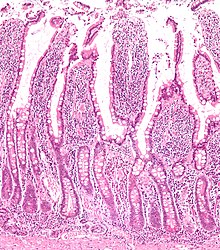Villi

Villi (singular is villus) are small, finger-like structures in the small intestine. They help to absorb digested food. Each villus has microvilli which increase the surface area of the intestinal walls. A larger surface area allows nutrients to be taken in more quickly.
The food (proteins, fats and carbohydrates) has already been broken down by enzymes called proteases, lipases and amylases. The amino acids and sugars (breakdown molecules of proteins and carbohydrates) go first into the blood stream. Then they are processed by the liver, which acts like a chemical factory for the body. Lipid substances (such as cholesterol) go first into the lymphatic system, and eventually into the blood stream and the liver.
